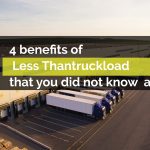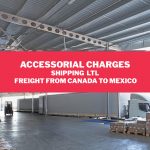Unveiling how do LTL rates work when shipping from Canada to Mexico
LTL rates calculation might be difficult to understand because there are many factors that play a role in the Less Than Truckload Freight transportation costs. LTL rates are based on weight, dimensions, equipment availability, route, fuel, density, handling, stowability and liability, among others. Less Than Truckload rates get even trickier when it comes to international shipments because additional or accessorial charges might apply.
In this post, we will explain to you how LTL rates work and what are the additional costs that apply when shipping international LTL from Canada and the US to Mexico.
If you would like to know the exact cost of an specific LTL shipment, going to Mexico from Canada, please contact us at info@mexicomlogisitics.com, call us 514-667-0174 o complete our quote form here. We will be more than happy to provide you with the LTL rate.
What determines LTL freight rates? How do LTL rates work?
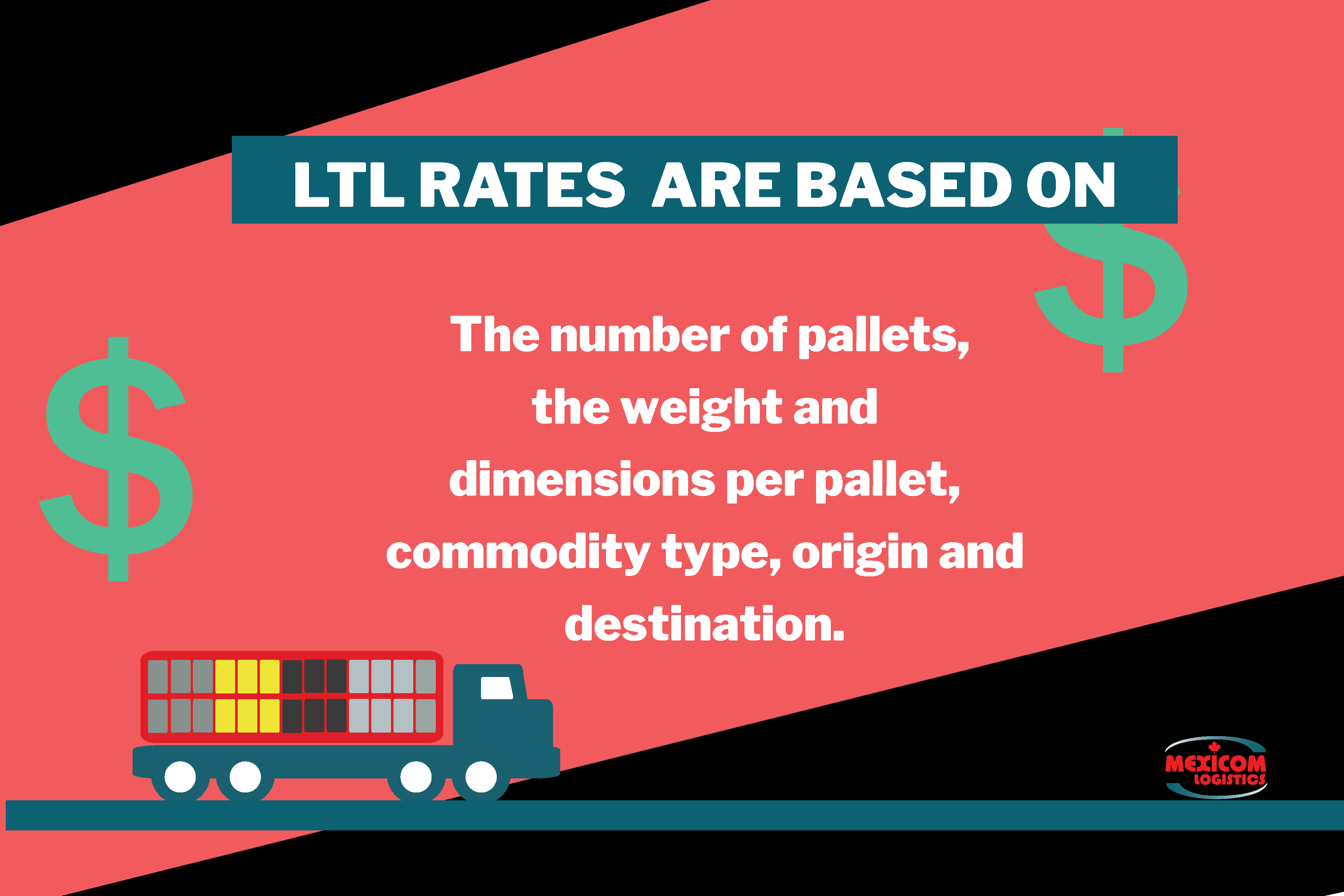
Let’s make a fast review of all the elements that play a role when calculating the LTL rates. LTL rates are calculated based on:
- the number of pallets,
- weight and dimensions per pallet
- commodity type
- origin
- destination
Make sure you provide this information to the transportation company when asking for an LTL freight quote.
Now, let’s analyze how each piece of information that is used to calculate the Less Than Truckload freight rates.
Weight
LTL freight rates are broken into weight categories per hundred pounds. In general terms: the heavier the shipment, the lower the rate per hundred pounds. For example, a shipment with a weight between 0 to 499 lbs will have a higher cost per hundred pounds than a load that falls in the 500 – 999 lb weigh break.
Please note that LTL shipping service is suitable for loads from 1 to 12 stackable pallets, which total weight is less than 10,000 pounds with a total length of 12 linear feet. Also, the weight of each pallet should not exceed 5,000 lbs.
If your load comprises 1-12 pallets but
a) it exceeds the maximum weight for a regular LTL (10, 000 lbs total weight or 4000 lbs per pallet) or
b) it needs to be loaded by the top or side of the truck or
c) it exceeds the maximum length for an LTL shipment: 12 linear feet.
Then, it needs to be transported as a partial load on a flatbed. Therefore, the rate will be calculated in a different way.
You may want to read: the type of loads that are commonly transported on Flatbeds
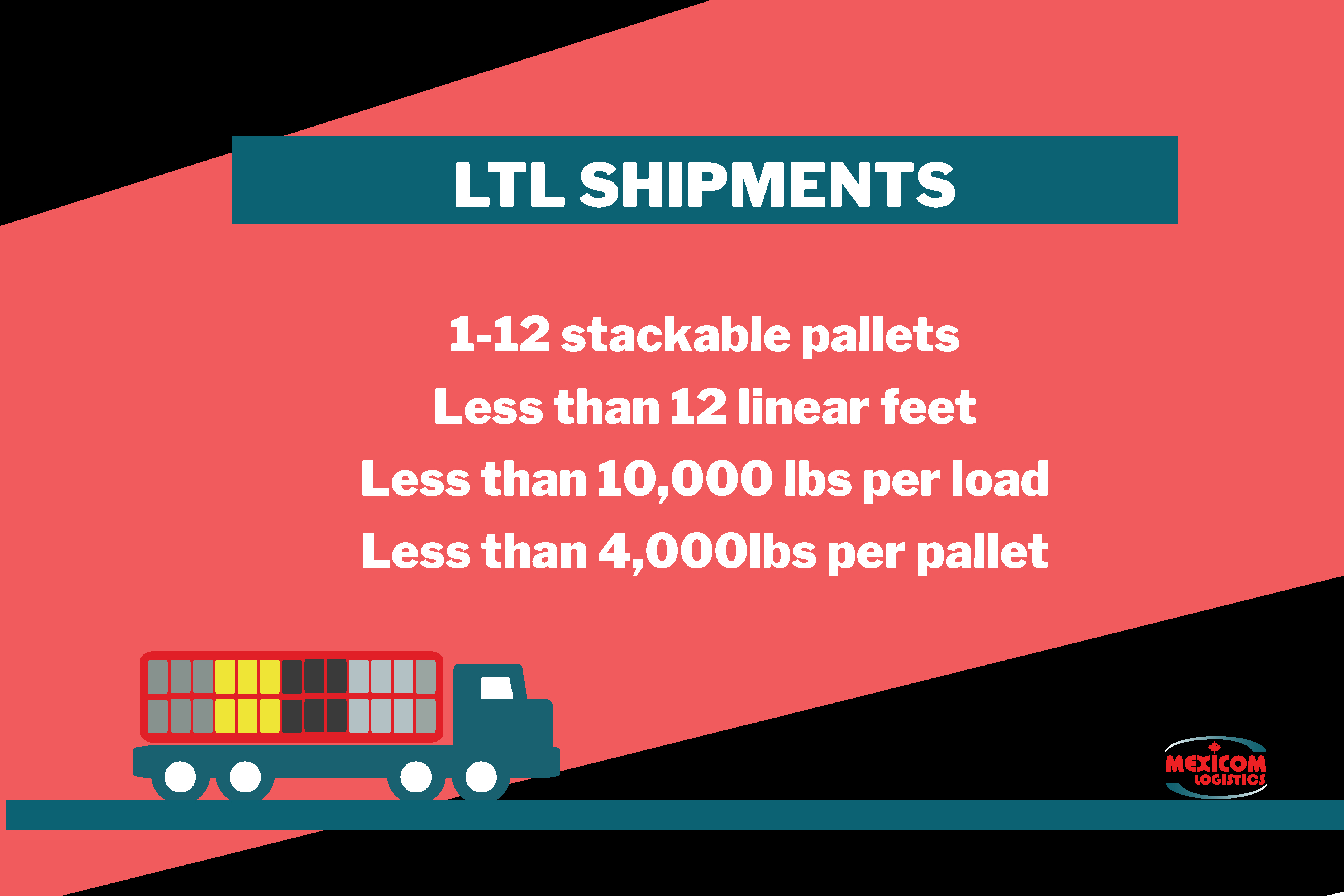
Freight Class
The freight class is one of the most important factors when calculating LTL rates. The lower the class, the lower the transportation fee.
The freight class is the number assigned to the LTL merchandise in the United States and Canada, according to its classification in the National Motor Freight Classification (NMFC). This classification depends on the level of “transportability” of the merchandise, which is determined by characteristics of the merchandise such as its density, handling, stowability, and liability.
When the handling characteristics, stowability and liability are not significant or unusual, the most important value to take into account for the classification of the merchandise is the density.
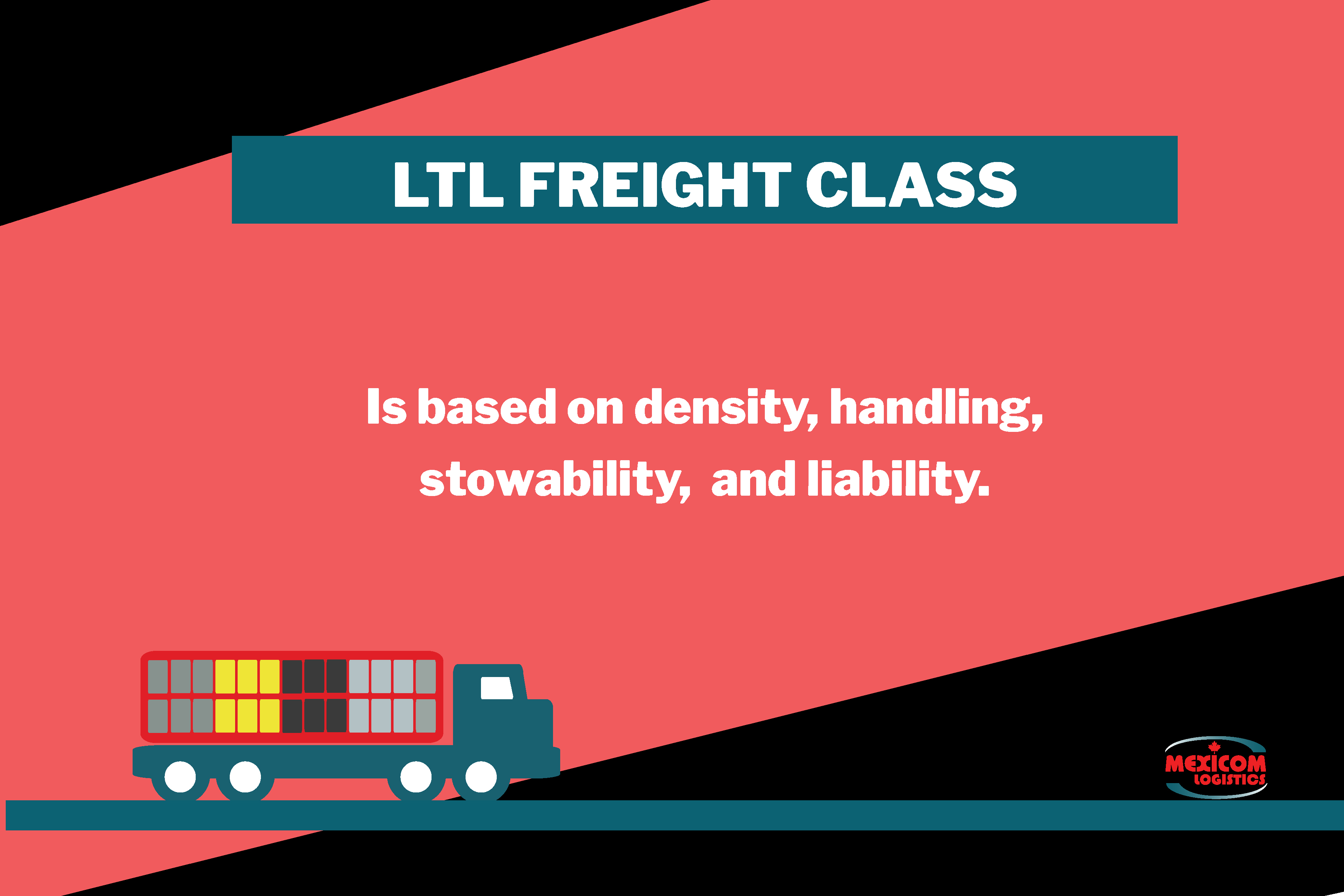
Density
First, it is necessary to know the pallet dimensions in order to be able to calculate its volume. Second, we need to know the volume and weight of each pallet to calculate density.
The calculation of the density of an object is obtained by dividing the mass among its volume, thus, the density of the pallet of 48x48x48 with 1250 lbs, is 23.4375
The higher the density, the lower the class. And, as we mentioned above, the lower the class, the lower the transportation fee.
If you want to know more about the freight class and density, please refer to our post: Understanding the freight class for LTL shipments
Distance/Fuel
As a general rule: The longer the distance, the higher the driver and the fuel costs. In other words, the price per pallet will increase if the distance is longer.
However, some LTL freight transport providers have lower rates on specific routes if they have a high demand for loads and if a pick-up point is located near one of its consolidation centers.
Let’s illustrate this point: The distance between Vancouver, BC, Canada and Leon City, Mexico (4,407km) is very similar to the distance between Montreal, QC, Canada and Leon City, Mexico (4,410 km). However, the rate that Mexicom Logistics offers to its customers for LTL shipments leaving from Montreal is lower than the rate for LTL shipments leaving from Vancouver. This is because of two reasons:
First, the number of loads that need to be transported from BC to Mexico is significantly lower than the number of LTL loads leaving from Quebec to Mexico. Ontario and Quebec account for more than 60% of the exports from Canada to Mexico.
Second, Mexicom Logistics has a consolidation center in Montreal, QC, Canada.
Route/Availability
As all transportation rates, LTL rates depend on supply and demand. Shipping LTL southbound, from Canada and the US to Mexico, will usually be cheaper than shipping Less Than Truckload freight northbound, from Mexico to Canada and the US.
Mexicom Logistics offers the lowest rates on LTL shipments from Canada and the US to Mexico.
Base Rates
LTL base rates are based on volume, demand and gross costs. For example, Mexicom Logistics offers lower rates on its LTL shipping lane from Montreal and Toronto to Mexico, because they have a good volume on this route.
Accessorial charges
Among the accessorial charges, there are two that will always apply when transporting Less Than Truckload Freight from Canada to Mexico. These are:
- The US-Mexico Border-Crossing Fee and
- The T&E bond
There are other accessorial & optional fees that apply only in specific situations, if you want to know more about other accessorial charges for LTL shipments from Canada to Mexico, please refer to our post on this topic.
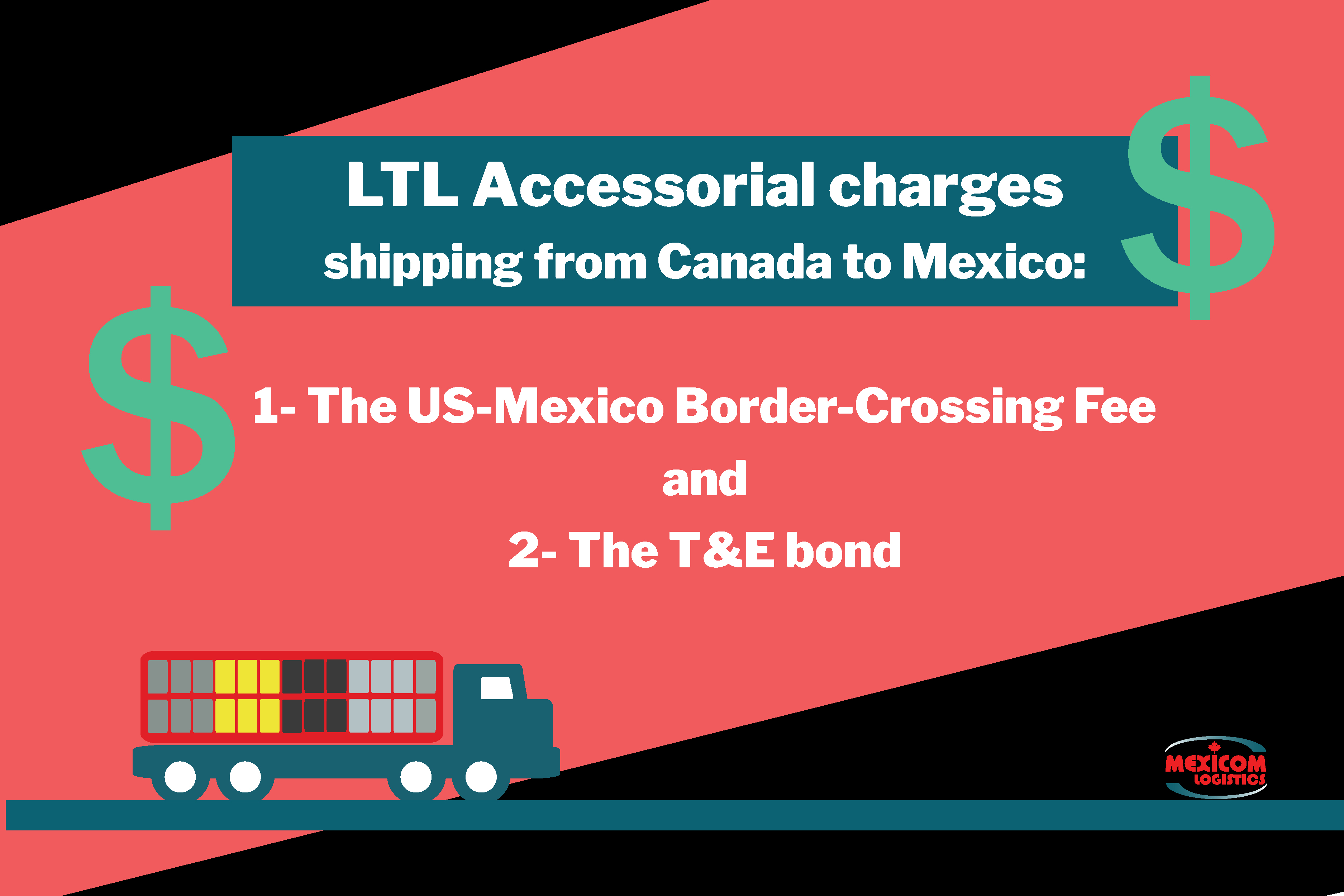
US-Mexico Border-Crossing Fee
To understand this fee, first, we need to understand how the freight transportation process from Canada to Mexico works. To make it simple, we can say that the land transportation process from Canada to Mexico comprises three steps:
First step: freight is transported from the pick-up point to the US side of the US-Mexico Border.
Second step: freight is transported between the two borders: from the US side of the border to the Mexican side of the border. This is a movement is called border crossing and is made by a “transfer”.
Third step: freight is transported from the Mexican side of the border to the final destination.
Often times, the border-crossing (step 2) is not included in the transportation service. But transportation companies can provide the service for a fee. Mexicom Logistics charges 150 USD for LTL freight US-Mexico bridge crossing.
One important thing to know is that in shipments coming from Mexico to the US or Canada, most reputable transportation companies will offer the border crossing service only if they are in charge of the whole shipment door to door, this means, from the point of origin in Mexico until the final destination in the US and Canada. This is for safety reasons, given that companies can not take the risk of crossing goods that were not under their control and supervision from the beginning of the transportation process.
T&E Bond (Only applies to shipments going from Canada to Mexico)
Shipments being transported through the United States, that are are not intended to be commercialized in that country, do not clear customs in the US border but need to be “bonded”. The customs bond is a form of insurance to protect the United States in the event that an importer or exporter does not pay the duties, taxes or fines incurred in their imports.
Companies specialized in the transportation of goods from Canada to Mexico, such as MexicomLogistics, take care of the bond, for a fee (75 USD).
For further information about the bond, you may want to read our post: Here is what you need to know about in-bonded shipments being transported from Canada to Mexico
As you may have noticed, LTL rates calculation is complex because it takes into consideration many factors. But no worries, if you need to ship LTL freight from Canada to Mexico, we will do the rate calculation for you and we will let you know all the accessorial charges that you need to consider. We love guiding our customers through the LTL shipping process form Canada to Mexico.









